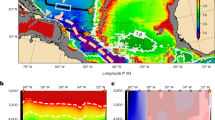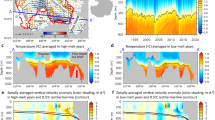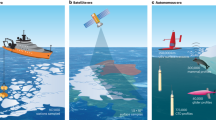Abstract
Deep ocean deoxygenation inferred from proxies has been used to support the hypothesis that a lower atmospheric carbon dioxide during glacial times was due to an increase in the strength of the ocean’s biological pump. This relies on the assumption that surface ocean oxygen (O2) is equilibrated with the atmosphere such that any O2 deficiency observed in deep waters is a result of organic matter respiration, which consumes O2 and produces dissolved inorganic carbon. However, this assumption has been shown to be imperfect because of disequilibrium. Here we used an Earth system model tuned to a suite of observations, which reproduces the pattern of glacial-to-Holocene oxygenation change seen in proxy data, to show that disequilibrium plays an important role in glacial deep ocean deoxygenation. Using a novel decomposition method to track O2, we found a whole-ocean loss of 33 Pmol O2 from the preindustrial to the Last Glacial Maximum despite a 27 Pmol gain from the increased solubility due to cooler temperatures. This loss was driven by a biologically mediated O2 disequilibrium, which contributed 10% of the reduction of the O2 inventory from the solubility equilibrium in the preindustrial compared with 27% during the Last Glacial Maximum. Sea ice and iron fertilization were found to be the largest contributors to the Last Glacial Maximum deoxygenation, which occurs despite overall reduced production and respiration of organic matter in the glacial ocean. Our results challenge the notion that deep ocean glacial deoxygenation was caused by a stronger biological pump or more sluggish circulation, and instead highlight the importance and previously underappreciated role of O2 disequilibrium.
This is a preview of subscription content, access via your institution
Access options
Access Nature and 54 other Nature Portfolio journals
Get Nature+, our best-value online-access subscription
$29.99 / 30 days
cancel any time
Subscribe to this journal
Receive 12 print issues and online access
$259.00 per year
only $21.58 per issue
Buy this article
- Purchase on Springer Link
- Instant access to full article PDF
Prices may be subject to local taxes which are calculated during checkout





Similar content being viewed by others
Data availability
The model output that support the findings of this study are available from https://doi.org/10.5281/zenodo.4078981. World Ocean Atlas data were obtained from https://www.nodc.noaa.gov/OC5/woa18/, and float data from the SOCCOM website https://soccom.princeton.edu/.
Code availability
Model codes are available from https://github.com/samarkhatiwala/tmm.
Change history
01 March 2021
A Correction to this paper has been published: https://doi.org/10.1038/s41561-021-00710-7
11 January 2021
A Correction to this paper has been published: https://doi.org/10.1038/s41561-021-00689-1
References
Broecker, W. S. Glacial to interglacial changes in ocean chemistry. Prog. Oceanogr. 11, 151–197 (1982).
Sigman, D. M., Hain, M. P. & Haug, G. H. The polar ocean and glacial cycles in atmospheric CO2 concentration. Nature 466, 47–55 (2010).
Jaccard, S. L. & Galbraith, E. D. Large climate-driven changes of oceanic oxygen concentrations during the last deglaciation. Nat. Geosci. 5, 151–156 (2012).
Jacobel, A. W. et al. Deep Pacific storage of respired carbon during the last ice age: perspectives from bottom water oxygen reconstructions. Quat. Sci. Rev. 230, 106065 (2020).
Bradtmiller, L., Anderson, R., Sachs, J. & Fleisher, M. A deeper respired carbon pool in the glacial equatorial Pacific Ocean. Earth Planet. Sci. Lett. 299, 417–425 (2010).
Galbraith, E. D. & Jaccard, S. L. Deglacial weakening of the oceanic soft tissue pump: global constraints from sedimentary nitrogen isotopes and oxygenation proxies. Quat. Sci. Rev. 109, 38–48 (2015).
Jaccard, S. L., Galbraith, E. D., Martínez-García, A. & Anderson, R. F. Covariation of deep Southern Ocean oxygenation and atmospheric CO2 through the last ice age. Nature 530, 207–210 (2016).
Anderson, R. F. et al. Deep-sea oxygen depletion and ocean carbon sequestration during the last ice age. Glob. Biogeochem. Cycles 33, 301–317 (2019).
Yamamoto, A., Abe-Ouchi, A., Ohgaito, R., Ito, A. & Oka, A. Glacial CO2 decrease and deep-water deoxygenation by iron fertilization from glaciogenic dust. Climate 15, 981–996 (2019).
Khatiwala, S., Schmittner, A. & Muglia, J. Air–sea disequilibrium enhances ocean carbon storage during glacial periods. Sci. Adv. 5, eaaw4981 (2019).
Sarmiento, J. L. & Gruber, N. Ocean Biogeochemical Dynamics (Princeton Univ. Press, 2006).
Stephens, B. B. & Keeling, R. F. The influence of Antarctic sea ice on glacial–interglacial CO2 variations. Nature 404, 171–174 (2000).
Ito, T. & Follows, M. J. Air–sea disequilibrium of carbon dioxide enhances the biological carbon sequestration in the Southern Ocean. Glob. Biogeochemical Cycles 27, 1129–1138 (2013).
Ito, T., Follows, M. J. & Boyle, E. A. Is AOU a good measure of respiration in the oceans? Geophys. Res. Lett. 31, L17305 (2004).
Wolf, M. K., Hamme, R. C., Gilbert, D., Yashayaev, I. & Thierry, V. Oxygen saturation surrounding deep water formation events in the Labrador Sea from Argo-O2 data. Glob. Biogeochem. Cycles 32, 635–653 (2018).
Russell, J. L. & Dickson, A. G. Variability in oxygen and nutrients in South Pacific Antarctic Intermediate Water. Glob. Biogeochem. Cycles 17, 1033 (2003).
Khatiwala, S., Primeau, F. & Holzer, M. Ventilation of the deep ocean constrained with tracer observations and implications for radiocarbon estimates of ideal mean age. Earth Planet. Sci. Lett. 325–326, 116–125 (2012).
Duteil, O. et al. A novel estimate of ocean oxygen utilisation points to a reduced rate of respiration in the ocean interior. Biogeosciences 10, 7723–7738 (2013).
Eggleston, S. & Galbraith, E. D. The devil’s in the disequilibrium: multi-component analysis of dissolved carbon and oxygen changes under a broad range of forcings in a general circulation model. Biogeosciences 15, 3761–3777 (2018).
Weaver, A. J. et al. The UVic Earth System Climate Model: model description, climatology, and applications to past, present and future climates. Atmos. Ocean 39, 361–428 (2001).
Schmittner, A. & Somes, C. J. Complementary constraints from carbon (13C) and nitrogen (15N) isotopes on the glacial ocean’s soft-tissue biological pump. Paleoceanography 31, 669–693 (2016).
Muglia, J., Skinner, L. C. & Schmittner, A. Weak overturning circulation and high Southern Ocean nutrient utilization maximized glacial ocean carbon. Earth Planet. Sci. Lett. 496, 47–56 (2018).
Schmidtko, S., Stramma, L. & Visbeck, M. Decline in global oceanic oxygen content during the past five decades. Nature 542, 335–339 (2017).
Bopp, L. et al. Multiple stressors of ocean ecosystems in the 21st century: projections with CMIP5 models. Biogeosciences 10, 6225–6245 (2013).
Gottschalk, J. et al. Biological and physical controls in the Southern Ocean on past millennial-scale atmospheric CO2 changes. Nat. Commun. 7, 11539 (2016).
Lu, Z. et al. Oxygen depletion recorded in upper waters of the glacial Southern Ocean. Nat. Commun. 48, 829–834 (2016).
Hoogakker, B. A. A., Elderfield, H., Schmiedl, G., McCave, I. N. & Rickaby, R. E. M. Glacial–interglacial changes in bottom-water oxygen content on the Portuguese margin. Nat. Geosci. 8, 40–43 (2015).
Bunzel, D. et al. A multi-proxy analysis of late quaternary ocean and climate variability for the Maldives, Inner Sea. Climate 13, 1791–1813 (2017).
Hoogakker, B. A. A. et al. Glacial expansion of oxygen-depleted seawater in the eastern tropical Pacific. Nature 562, 410–413 (2018).
Umling, N. E. & Thunell, R. C. Mid-depth respired carbon storage and oxygenation of the eastern equatorial Pacific over the last 25,000 years. Quat. Sci. Rev. 189, 43–56 (2018).
Durand, A. et al. Reduced oxygenation at intermediate depths of the southwest Pacific during the Last Glacial Maximum. Earth Planet. Sci. Lett. 491, 48–57 (2018).
Lu, W. et al. I/Ca in epifaunal benthic foraminifera: a semi-quantitative proxy for bottom water oxygen in a multi-proxy compilation for glacial ocean deoxygenation. Earth Planet. Sci. Lett. 533, 116055 (2020).
Kohfeld, K. E., Quéré, C. L., Harrison, S. P. & Anderson, R. F. Role of marine biology in glacial–interglacial CO2 cycles. Science 308, 74–78 (2005).
Waelbroeck, C. et al. Constraints on the magnitude and patterns of ocean cooling at the Last Glacial Maximum. Nat. Geosci. 2, 127–132 (2009).
Benz, V., Esper, O., Gersonde, R., Lamy, F. & Tiedemann, R. Last Glacial Maximum sea surface temperature and sea-ice extent in the pacific sector of the southern ocean. Quat. Sci. Rev. 146, 216–237 (2016).
Matsumoto, K., Hashioka, T. & Yamanaka, Y. Effect of temperature-dependent organic carbon decay on atmospheric \(p_{{\rm{CO}}2}\). J. Geophys. Res. Biogeosci. 112, G02007 (2007).
Oka, A., Abe-Ouchi, A., Chikamoto, M. O. & Ide, T. Mechanisms controlling export production at the LGM: effects of changes in oceanic physical fields and atmospheric dust deposition. Glob. Biogeochem. Cycles 25, GB2009 (2011).
Schmittner, A., Galbraith, E. D., Hostetler, S. W., Pedersen, T. F. & Zhang, R. Large fluctuations of dissolved oxygen in the Indian and Pacific Oceans during Dansgaard–Oeschger oscillations caused by variations of North Atlantic Deep Water subduction. Paleoceanography 22, PA3207 (2007).
Roche, D. M., Crosta, X. & Renssen, H. Evaluating Southern Ocean sea-ice for the Last Glacial Maximum and pre-industrial climates: PMIP-2 models and data evidence. Quat. Sci. Rev. 56, 99–106 (2012).
Smith, J. A., Hillenbrand, C.-D., Pudsey, C. J., Allen, C. S. & Graham, A. G. C. The presence of polynyas in the Weddell Sea during the last glacial period with implications for the reconstruction of sea-ice limits and ice sheet history. Earth Planet. Sci. Lett. 296, 287–298 (2010).
Zanowski, H., Hallberg, R. & Sarmiento, J. L. Abyssal ocean warming and salinification after Weddell polynyas in the GFDL CM2G coupled climate model. J. Phys. Oceanogr. 45, 2755–2772 (2015).
Conway, T., Wolff, E., Röthlisberger, R., Mulvaney, R. & Elderfield, H. Constraints on soluble aerosol iron flux to the Southern Ocean at the Last Glacial Maximum. Nat. Commun. 6, 7850 (2015).
Shoenfelt, E. M., Winckler, G., Lamy, F., Anderson, R. F. & Bostick, B. C. Highly bioavailable dust-borne iron delivered to the Southern Ocean during glacial periods. Proc. Natl Acad. Sci. USA 115, 11180–11185 (2018).
Galbraith, E. D. & Skinner, L. C. The biological pump during the Last Glacial Maximum. Annu. Rev. Mar. Sci. 12, 559–586 (2020).
Galbraith, E. D. & Martiny, A. C. A simple nutrient-dependence mechanism for predicting the stoichiometry of marine ecosystems. Proc. Natl Acad. Sci. USA 112, 8199–8204 (2015).
Matsumoto, K., Rickaby, R. & Tanioka, T. Carbon export buffering and CO2 drawdown by flexible phytoplankton C:N:P under glacial conditions. Paleoceanogr. Paleoclimatol. 35, e2019PA003823 (2020).
Ödalen, M. et al. Variable C/P composition of organic production and its effect on ocean carbon storage in glacial-like model simulations. Biogeosciences 17, 2219–2244 (2020).
Garcia, H. E. et al. World Ocean Atlas 2018 Volume 3: Dissolved Oxygen, Apparent Oxygen Utilization, and Oxygen Saturation (NOAA, 2018).
Drucker, R. & Riser, S. C. In situ phase-domain calibration of oxygen Optodes on profiling floats. Methods Oceanogr. 17, 296–318 (2016).
Johnson, K. S. et al. SOCCOM Float Data—Snapshot 2017-06-06 (UC San Diego Library Digital Collections, 2017).
Gottschalk, J. et al. Carbon isotope offsets between benthic foraminifer species of the genus Cibicides (Cibicidoides) in the glacial sub-Antarctic Atlantic. Paleoceanography 31, 1583–1602 (2016).
Muglia, J., Somes, C. J., Nickelsen, L. & Schmittner, A. Combined effects of atmospheric and seafloor iron fluxes to the glacial ocean. Paleoceanography 32, 1204–1218 (2017).
Lambert, F. et al. Dust fluxes and iron fertilization in Holocene and Last Glacial Maximum climates. Geophys. Res. Lett. 42, 6014–6023 (2015).
Mahowald, N. M. et al. Atmospheric iron deposition: global distribution, variability, and human perturbations. Annu. Rev. Mar. Sci. 1, 245–278 (2008).
Lambeck, K., Rouby, H., Purcell, A., Sun, Y. & Sambridge, M. Sea level and global ice volumes from the Last Glacial Maximum to the Holocene. Proc. Natl Acad. Sci. USA 111, 15296–15303 (2014).
Khatiwala, S., Visbeck, M. & Cane, M. A. Accelerated simulation of passive tracers in ocean circulation models. Ocean Model. 9, 51–69 (2005).
Khatiwala, S. A computational framework for simulation of biogeochemical tracers in the ocean. Glob. Biogeochem. Cycles 21, GB3001 (2007).
Khatiwala, S. Transport Matrix Method Software for Ocean Biogeochemical Simulations https://doi.org/10.5281/Zenodo.1246300 (2018).
Muglia, J. & Schmittner, A. Glacial Atlantic overturning increased by wind stress in climate models. Geophys. Res. Lett. 42, 9862–9868 (2015).
Abe-Ouchi, A. et al. Ice-sheet configuration in the CMIP5/PMIP3 Last Glacial Maximum experiments. Geosci. Model Dev. 8, 3621–3637 (2015).
Bereiter, B., Shackleton, S., Baggenstos, D., Kawamura, K. & Severinghaus, J. Mean global ocean temperatures during the last glacial transition. Nature 553, 39–44 (2018).
Sarnthein, M., Schneider, B. & Grootes, P. M. Peak glacial 14C ventilation ages suggest major draw-down of carbon into the abyssal ocean. Climate 9, 2595–2614 (2013).
Skinner, L. C. et al. Radiocarbon constraints on the glacial ocean circulation and its impact on atmospheric CO2. Nat. Commun. 8, 16010 (2017).
Acknowledgements
This study was supported by UK NERC grants NE/M020835/1 and NE/T009357/1 to S.K., and US National Science Foundation grant OCE-1924215 to A.S. E.C. acknowledges support from the Rhodes Trust. Computing resources were provided by the Climate Simulation Laboratory at NCAR’s Computational and Information Systems Laboratory (ark:/85065/d7wd3xhc), sponsored by the National Science Foundation and other agencies, and the University of Oxford Advanced Research Computing (ARC) facility (https://doi.org/10.5281/zenodo.22558). Data shown in Fig. 1 were collected and made freely available by the Southern Ocean Carbon and Climate Observations and Modeling (SOCCOM) Project funded by the National Science Foundation, Division of Polar Programs (NSF PLR -1425989), supplemented by NASA, and by the International Argo Program and the NOAA programmes that contribute to it. The Argo Program is part of the Global Ocean Observing System.
Author information
Authors and Affiliations
Contributions
S.K. and A.S. designed the study; S.K. carried out the experiments; all the authors analysed the results; E.C. wrote the manuscript with input from S.K. and A.S.
Corresponding author
Ethics declarations
Competing interests
The authors declare no competing interests.
Additional information
Publisher’s note Springer Nature remains neutral with regard to jurisdictional claims in published maps and institutional affiliations.
Supplementary information
Supplementary Information
Supplementary Figs. 1–26 and discussion.
Rights and permissions
About this article
Cite this article
Cliff, E., Khatiwala, S. & Schmittner, A. Glacial deep ocean deoxygenation driven by biologically mediated air–sea disequilibrium. Nat. Geosci. 14, 43–50 (2021). https://doi.org/10.1038/s41561-020-00667-z
Received:
Accepted:
Published:
Issue Date:
DOI: https://doi.org/10.1038/s41561-020-00667-z
This article is cited by
-
Response of Arctic benthic foraminiferal traits to past environmental changes
Scientific Reports (2023)
-
Recovery from microplastic-induced marine deoxygenation may take centuries
Nature Geoscience (2023)
-
Southern Ocean glacial conditions and their influence on deglacial events
Nature Reviews Earth & Environment (2023)



